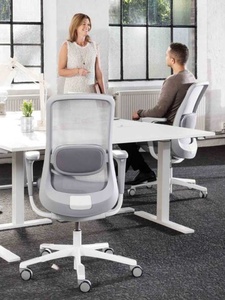We need to protect lab workers health
Lab work often requires forward leaning, repetitive movements, awkward postures and varied desk heights; all of which put lab workers more at risk of experiencing work-related back pain, neck pain, shoulder pain and wrist pain when compared to other workers. Working in regular pain or discomfort impacts your ability to work effectively and can be a sign that there could be more long-term damage to your health if you continue as you are.
Everybody wants to work in comfort. According to the HSA back pain is the most commonly reported area of discomfort followed by wrist and hand pain, all of which are areas of discomfort regularly reported among scientists in the lab (HSA, 2016). Further research, in the form of a 10-year literature review on lab technicians, found that when it came to Musculoskeletal Disorders (MSD), the lower back and neck were the most common areas for discomfort and pain. (Poignet et al, 2017)
In laboratories, scientists are often working at awkward heights and angles, carrying out repetitive tasks for extended periods. When it comes to work related pain, this can result in a snowball effect! These repetitive movements can be exacerbated by equipment that isn’t suitable or set up for the user. Couple this with a lack of space, a limited understanding of ergonomics, a lack of awareness of how you move and the postures you maintain, and there’s bound to be some discomfort further down the line.
Protecting Lab Workers Health is a Challenge for all Laboratories.
At KOS Ergonomics, we are lucky to work with some of Ireland’s top laboratories in some of the country’s largest hospitals and for some of the world’s largest pharmaceutical companies. Protecting Lab Workers Health is a challenge for all organisations. Although labs will vary in their investigative processes and their output, when it comes to ergonomics common issues tend to arise. These kinds of niggling frustrations among the team can affect the productivity when carrying out certain tasks affecting overall work output! They can also have a negative impact on team morale.
Questions like ‘Why should we have to work through this discomfort?’ or ‘Is there anything that we could do to improve this setup’ can be thrown around.
It’s not all doom and gloom however the reality is there are almost always improvements that can be made!
In both medical and pharmaceutical labs, senior members of the lab or Lab Managers often hear of issues but may not have the time to or be aware of how to improve their current surroundings. This article will give you some tips to help you reduce work related discomfort in your lab and ensure you’re creating the healthiest possible environment for your team!
Simple Steps to Improving Employee Comfort in Labs
1) Relax
Keep your team relaxed! Although easier said than done when workloads are high, or deadlines are approaching and you are as busy as ever - staying relaxed, physically and mentally, while you work will have a significant benefit on your team’s level of comfort. Stress and prolonged muscle tension are major contributing factors to developing pain, especially back pain. Focus on diaphragmatic breathing or ‘belly breathing’. By doing this there is an increase in the activation of the parasympathetic nervous system. Which has been identified as a method of reducing stress and therefore pain (Hallman and Lyskov, 2012).
2) Maintain Good Posture
Within any occupation, posture is important. Be it typing a report on your computer or pipetting, regardless of the task you want to ensure that you are sitting properly and maintaining a healthy posture. Slouching makes it difficult for your muscles and ligaments to keep you balanced and can lead to headaches, back pain, and other problems. Utilise posture watch posters** throughout your lab to encourage healthy postures. Scientists should avoid dangling their feet, hunching their shoulders, or contorting their necks when pipetting liquids. Suitable equipment should be used to allow scientists sit in a healthy posture.
3) Rotate Tasks
In multi-user labs regular task rotation should be encouraged. This technique is an important part of minimizing discomfort in the shoulder, back, neck, wrist and hands, by varying the load on the muscle. Where possible, rotate every hour to alternate tasks which involve different muscle groups. This will allow for proper recovery and help prevent muscular strain. It should also have an improved effect on productivity.
4) Maintain Clean and Tidy Workstations
Although labs normally have multi-user workstations, a conscious effort should be made to maintain clean and tidy workstations. By encouraging your team to organize the workstations, you will reduce clutter, increase lab safety, and improve overall ergonomics. Once organized you can position your supplies like pipette tips, buffers and samples in such a way that you are minimizing repetitive awkward movements or postures. Have everything used at the workstation within arm’s reach. Otherwise encourage movement by having certain items or equipment located far enough from the workstation that users must leave their chair.
5) Educate your team on Ergonomics
You could have the best equipment available but if your team doesn’t understand how to set themselves up correctly then the features are wasted! Encourage your colleagues to set up their chair and workstation each time they are going to do a period of continuous work.
As most labs are multi use environments it is very important to learn how to set yourself up with all the relevant equipment. Education both on setup and on use are vital contributors to a comfortable and happy workforce. Ensure that each of your team is working with the most suitable equipment for their anthropometric requirements and for the tasks they’re carrying out. Ensure your chair or saddle are the correct fit for you and you know how to adjust each feature to get maximum support.
Remember that taking 1 minute prior to beginning a task to ensure you are well supported and the workstation is set up to reduce the likelihood of forward head tilt and repetitive strain will be the most important minute of the day.
6) Encourage Regular Micro-Breaks
The school of thought was once that holding an upright fixed position was most beneficial to managing back discomfort however the current evidence preaches more to the need for movement. Encourage movement among your team. If you are doing a task that requires long periods at the workstation, get up and move every 45 minutes or as frequently as possible, grab a drink of water, pop over to a colleague and ask a question – create reasons to move. Shorter and more frequent breaks throughout the working day will be most beneficial when It comes to managing or avoiding discomfort.
How to make further improvements to your lab environment
An excellent way for you to take the next step towards making your lab a healthier place to work is to carry out an ergonomic review of your lab. KOS Ergonomics have a team of ergonomic specialists with backgrounds in ergonomics, physiotherapy, health and performance science, nutrition and interior architecture. We’ve worked with some of Ireland’s top labs to help make their labs healthier and more comfortable places to work. We can help you do the same with your lab.
3 Steps to making your lab healthier and more productive:
- Carry out an ergonomic review of areas within the lab
- The Ergonomic Consultant will review the work environment, anthropometric requirements of teams, lab tasks, suitability of equipment and individual issues.
- Identify compliance issues and give you a better understanding of the general problem areas for scientists
- Get a better understanding of how to effectively work at awkward heights or with minimal space.
- Report is issued with findings of ergonomic review and a recommended plan with steps to follow to improve the ergonomics with the goal of improving scientist comfort and productivity.
- Ergonomic Consultant will guide and support the implementation of the plan
- Focus is on the easy wins first, tackling the frustrating problem areas the team keep mentioning that are easy to resolve.
- Look at impact of change and effort to make change to prioritise actions
- Guidance throughout the process.
An ergonomic review will give you a foundation from which you can focus on developing a more comfortable lab for your team. A more comfortable lab means better team morale, significantly less chance of injury and creating a far healthier place for your team to work!
To arrange for an Ergonomic Review of your lab please email sales@kos.ie or call 01 6110 200.
**Emails sales@kos.ie for Posture Watch posters
References;
O’Sullivan, P.B., Caneiro, J.P., O’Keeffe, M., Smith, A., Dankaerts, W., Fersum, K. and O’Sullivan, K., 2018. Cognitive functional therapy: an integrated behavioral approach for the targeted management of disabling low back pain. Physical therapy, 98(5), pp.408-423.
Pougnet, R., Loddé, B., Uguen, M., Sawicki, B. and Pougnet, L., 2017, November. Medical laboratory technician professional pathologies: a 2006-2016 literature review. In Annales de biologie clinique (Vol. 75, No. 6, pp. 664-672)
Holm, J.W., Mortensen, O.S. and Gyntelberg, F., 2016. Upper limb disorders among biomedical laboratory workers using pipettes. Cogent Medicine, 3(1), p.1256849
De Beeck, R.O. and Hermans, V., 2000. work-related low back disorders. Bilbao, Spain.
Loisel, P., Gosselin, L., Durand, P., Lemaire, J., Poitras, S. and Abenhaim, L., 2001. Implementation of a participatory ergonomics program in the rehabilitation of workers suffering from subacute back pain. Applied ergonomics, 32(1), pp.53-60
https://www.intechopen.com/books/pain-in-perspective/autonomic-regulation-in-musculoskeletal-pain















